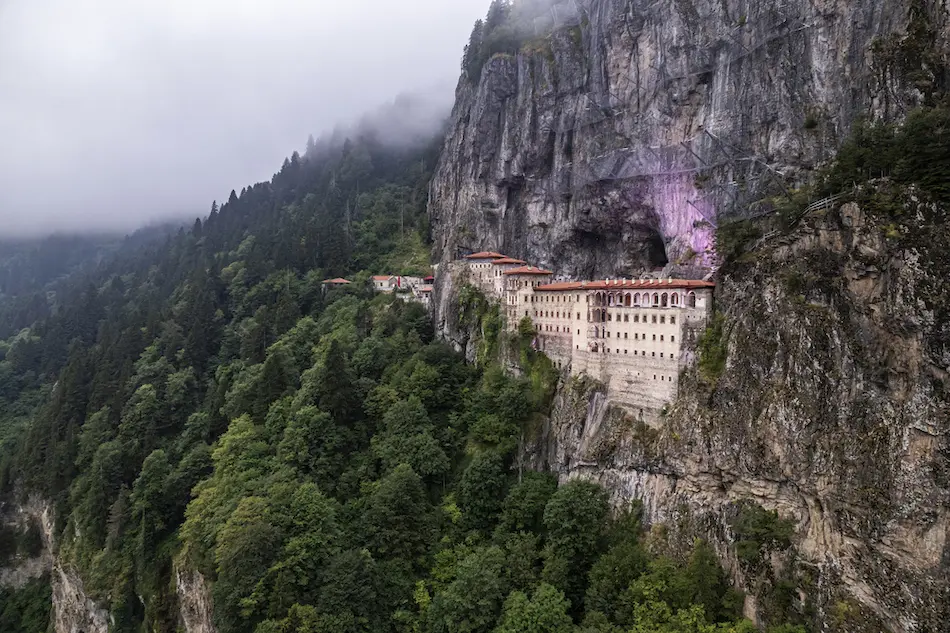Belonging to another time, the churches in Turkey are much more than places of worship and reflection of religion. They also highlight church history. Some belonged to ancient cities, of which the Christian community practised secretly in fear of retribution from Romans. Others reflect the beginning of Christian heritage, a prime place from which the early words of Christianity spread.
Indeed, it surprises people to learn about the lives of prominent Christians in these lands. Saint Paul, the Virgin Mary, the Cappadocia fathers, and Saint John spent time in ancient churches. Of course, in those days, the Turkish Republic didn't exist. Over time, various empires ruled, including the Persians, Lycians, Alexander the Great, and the Ottomans. But if you want to learn about Christian history in Turkey, today's historic churches are an excellent place to start.
11 Famous Churches in Turkey
1: Saint Peter Antakya
This historic structure is one of the world’s oldest churches. Used by early Christians, parts of the Antakya Orthodox Church, including floor mosaics, date from the 4th century. While it is no longer in use, its history shines through in its museum status. In 1932, possibly as a mark of respect, a statue of Saint Peter was placed on top of the altar, and pilgrims head there for spiritual guidance.
2: Seven Churches of Revelation in Asia Minor
Anyone who knows their Bible will confirm that the Seven Churches of Revelation mentioned in the New Book of Revelation were not Christian churches but cities full of people with busy lives. Developing out of what was then the Jewish population, all churches of Asia received a message asking for reform from pagan practices while praising what they did well. Remains of those cities sit all over Turkey’s Aegean coast and include ancient ruins from Laodicea, Sardis, Smyrna, and Philadelphia church.
The key site is the magnificent Ephesus, who John praised for not following false prophets. Now the second most visited attraction, extensive excavations have revealed several public buildings, including the Celsus Library. However, minor signs dotted around the city directed Christians to places where they could peacefully practise the chief religion. A guided tour of all seven sites takes roughly four days and requires overnight accommodation.

3: Church of St. Anthony of Padua in Istanbul
Built in 1912 and called Sant'Antonio di Padova Church building, this holy place is the largest Roman Catholic church in Istanbul, and anyone who walks over the threshold is instantly in awe. The interior decor, including large stained-glass windows, rows of polished pews and a calming, silent atmosphere, attracts Christian worshippers to this day. John XXIII preached here and his devotion to the community and neighbourhood led to his nickname of "The Turkish Pope."

4: The Virgin Mary's House in Selcuk
High in the hills, above the ancient ruins of Ephesus, is a small Catholic building. Years before, a nun who had never been to Turkey dreamt of a house where the Virgin Mary spent her last days before she ascended. A historian followed the nun's description to find the small house in Selcuk. It has never been verified that it is her last resting place, but the Catholic church funds the premises and often hold services on weekends and special religious occasions. While there, visit the Basilica of John the Apostle in the centre of Selcuk. Izmir airport is just a one-hour drive away to see all these sites on one holiday.

5: Ani - The city of 1001 Churches
Sadly, few people venture East to the ruined churches of Ani, which sit on the border with Armenia. Covering a large, extensive area, they include the St Gregory of Tigran Honents, the Holy Redeemer, and a Cathedral boasting a spectacular high ceiling. What we see today is just a tiny part of the old Armenian kingdom of Ani. There is much more to discover, but if you are in the eastern region of Kars, stop by to see this awe-inspiring ancient city.

6: Church Sites of Cappadocia
One of Turkey's best regions to explore the rich heritage is the central Anatolian area of Cappadocia. As one of the first places to embrace early Christianity during Biblical times, followers listened to preachers like Gregory of Nyssa and Basil the Great, who were local citizens but later became saints. A collective group is the Goreme Open Air Museum, a UNESCO World Heritage site of cave churches dating from the 4th and 5th centuries. Historians estimate that over 3000 cave churches exist in Cappadocia, famous for its lunar-like landscape.
When Cappadocia embraced Islam in the 15th century, locals used them as pigeon sheds instead. Painstaking restoration work has revealed some fine examples of early Christian frescoes in churches such as Barbara, Apple, and Snake. Sitting just outside the boundaries, though, is the magnificent Buckle Church, which displays frescoes depicting Biblical scenes, including the journey to Bethlehem. While there, visit the marvellous underground cities.

7: Church of St. Nicholas
For Christian populations, Demre on the Mediterranean coast is a place of pilgrimage because of one man. Saint Nicholas was, in fact, the man that we now call Santa Claus. He was born in Patara in the 4th century and became a Christian bishop of Myra. Called the patron, saint of sailors, his remains were interred in a coffin, and placed in the newly built church, roughly 200 years after his death. However, Italian sailors took them to the Basilica di San Nicola. This site is significant for Eastern Orthodox Christians and Roman Catholics. Many tourists also visit the nearby ancient city ruins of Myra, which are further inland.
8: Sumela Monastery
Although not often mentioned, the Sumela monastery is of great interest. Dating back to ancient times around AD386 and sitting near the bustling city of Trabzon, the cultural heritage revolves around two monks who built the monastery in that position because they saw a vision of the black virgin Mary. It is a long walk up and sits 1200 metres high on a cliff in Macka National Park.
The monastery received protected rights under the rule of Ottoman Sultan Mehmed the 2nd in the 15th century. Christian denominations continued to head there, until the collapse of the Ottoman Empire in 1923. Services for Orthodox Christians have taken place in the past. Following a closure of three years for renovation, the monastery is once again open to the public as a prominent Christian site.

9. Deyrulzafaran Monastery
Also called Mor Hananyo Saffron Monastery, it was built in 493AD for the Syriac Orthodox (Assyrian) Christian sect but underwent restoration in 2007. Relics like old Bibles are on display. Sadly, few people see it or hear about it since it sits in Turkey’s Mardin region, which is not a strong tourism stronghold.
10: The 10th Century Akdamar - Holy Cross Cathedral
Knowing about ancient life is interesting, especially when encountering landmarks like the Akdamar Cathedral of Lake Van. Also called the Holy Cross Cathedral, the pink volcanic tufa rock structure is a perfect introduction to cultural life from that era. Having opened as a museum in 2005, history enthusiasts will enjoy cultural tours of the area to understand the Armenian communities better.
11: Churches in Istanbul
At one stage, Constantinople was a melting pot of cultures and religions. The old Jewish communities used to live in what is now the Galata Quarter, and the synagogue still opens these days, although you need permission to enter. The Armenian church had a heavy presence, and there are various 19th-century Armenian churches on streets instantly recognisable by their distinct architectural styles. Indeed, the city was home to several Christian factions, and some that are open to the public or hold regular masses today include Mar Chaldean church for the Chaldean community, the Bulgarian St—Stephen church in Balat, and the holy trinity Greek catholic cathedral in the Beyoglu district. The Ecumenical Patriarch of Constantinople of the Greek Orthodox church is based here.
About the Hagia Sophia
The Hagia Sophia, which sits in the modern city of Istanbul, which has roughly 18 million people, started life as a Byzantine cathedral. Unfortunately, the original version burned to the ground, so the Byzantine empire built a new one. The domed ceiling was the world’s largest. Then, the Ottoman Empire conquered Istanbul, and they converted this ancient site into a mosque. Fast forward nearly 5000 years, the Ottomans disbanded, and the New Turkish Republic turned the historic structure into a museum. The marvellous structure is now a mosque again, but tourists can still visit outside during prayer.

Also About Turkey
Famous Mosques: From one religion to another, Turkey also has many famous mosques, dating from the Ottoman times, that attract Muslims from near and far. Some stand out as imperial mosques, while others are famous for their architectural styles and stories behind their construction.
Famous Mountains: From churches in Turkey to tall, towering peaks that dominate the landscape, the power of Mother Nature shines through. Whether you are a geography freak or looking for adventures to climb, these mountains portray the best landscapes in Turkey.














 Istanbul
Istanbul  3
3  2
2 

















 X
X